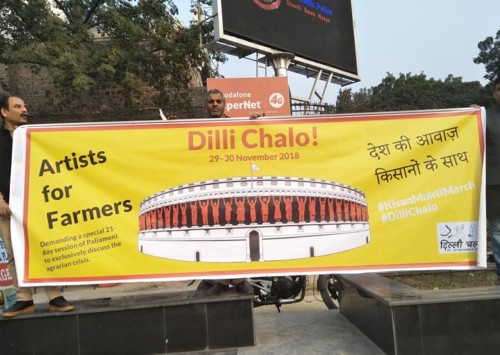Farmers protest over the deepening agrarian crisis in India
It is not just the uncertain nature that push the farmers toward desperate measures of protesting or ending their lives, but apathy from the government towards the agriculture sector has also undermined it.
Indian agriculture has been hit by a depleting water table and declining productivity for decades. Around 330 million Indians were affected by the 2015-16 drought alone. Low rainfall marked 13 of the last 18 years, and seven of them were declared drought years by the Indian Meteorological Department. It was a direct blow to farmers, especially for those who are directly dependent on agricultural production and make up more than three-fourths of India’s 1.3 billion people. This year in India, farmers have felt the beginning of the apocalypse in the form of dried up wells, declining yields and mass migrations of people. Costs are mounting but the real farm income has grown less than half a percent annually. An Indian farmer today, earns under INR 20,000 on an average, per year, which is a quarter of India’s per capita income.
The plight of farmers of a nation is not just dependent on nature, but also on the policies of the government of the nation. In India, half of its population works on farms, but farming contributes to only 15 pc to the country’s GDP. The figures show massive negligence on the part of the government in boosting the growth accruing to this sector.
Each state has a different story to tell as farmers stage their local battles with debt owed to banks and money lenders, and the most generous state actions in response to these are mostly short-lived. One of the chief demands of the farmers is a special parliamentary session to discuss solutions to the agrarian crisis, including a full loan waiver and higher crop prices, which now might have been agreed by few states, but others are still witnessing frequent protests.
Farmers protest in different parts of the country
Protests by farmers have intensified in the past two years as they try to draw attention to the usually forgotten countryside — their recent march to Delhi, was their fourth and largest arch, so far this year. On November 30, tens of thousands of farmers from across India took to streets of the capital demanding relief from debt, higher prices for their produce and a special session of parliament dedicated to their needs.
On the very next day, the farmers held a protest on the Mumbai-Agra National Highway against declining onion prices. Some farmers even shaved their heads as a mark of protest. While police had to rush to the spot to clear traffic jam, the farmers’ concerns continue to persist. They claimed that onion prices were sliding for the last two weeks and the government was unable to stop it. In Madhya Pradesh’s Neemuch mandi, onions were sold for as low as 50 paise per kg which put local farmers in a state of frenzy.
They have also held marches in other cities like Kolkata and Mumbai. In June, farmers in several parts of the country threw their produce on the streets to highlight low prices. And last year, farmers from southern India protested in New Delhi with skulls to draw attention to suicides by farmers. An estimated 250,000 farmers have committed suicide in the last 15 years, and the United Nations Commission on Sustainable Development observed that, between 1997 and 2005, a farmer committed suicide every 32 minutes in India.













